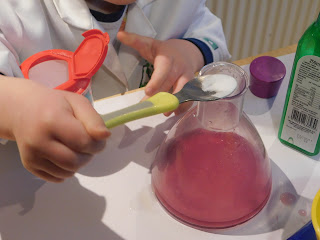My son noticed that, when I made a blueberry and lemon cake, the blueberries didn't live up to their name and were bright pink. This made me think that blueberries probably get their colour from anthocyanins which are pH-sensitive. We have previously had lots of fun doing colour changing activities with
red cabbage and, on one occasion, with
poinsettia. Both red cabbage and poinsettia get their colour from anthocyanins. I thought we could therefore experiment with blueberries and see whether we could get a colour change, and it worked brilliantly!
 |
| Adding lemon juice to blueberry liquid |
To make the blueberry liquid I took 8 large and slightly squishy blueberries from the pack, which were past their best, and microwaved them for 30 seconds in about 30ml water. I then blended the cooked blueberries and strained the mix through a muslin cloth. This gave a deep red liquid which I diluted about 1 part in 3 before my son experimented with it, so if easier you could add more liquid in when heating the blueberries.
 |
| Adding bicarbonate of soda to blueberry liquid |
I gave my son less than half of the mix in a conical flask from his science set, but a white or clear plastic pot would work just fine. He chose to add acid in the form of lemon juice first, and put a generous squirt in then swirled it to mix. The liquid went a brighter shade of pink!
 |
| The liquid is dark blue when it is alkaline |
We chose to keep the pink liquid in one of our big test tubes to compare to what happened if we made the blueberry liquid alkaline instead of acidic. I gave him most of the rest of the blueberry liquid (just keeping a little back for colour comparison) in the conical flask, and he carefully spooned in some bicarbonate of soda (about 1 level teaspoon). This didn't mix so well initially but he could see the liquid around the white powder turning deep blue. He put the stopper in his flask and vigorously mixed it (it's a good job they fit snugly...!) and was excited to find all the liquid had turned very dark blue (he thought it was almost black).
 |
| Tubes of acidic (left) and alkaline (right) blueberry liquid |
He was so excited about the colour change that I thought of another way he could play with it. The muslin cloth I'd used to strain the liquid was stained with the blueberry colour even though I'd given it a quick rinse, so I suggested he could try putting a little lemon juice or bicarbonate of soda on that to see whether it changed colour. He was really keen to try!
 |
| Alkaline (left) and acidic (right) blueberry solution either side of the original liquid |
He had a lot of fun with the muslin, adding lemon juice and bicarbonate of soda to different parts of the purple-stained cloth and seeing the colour change. Interestingly the liquid was a deeper pink than the stain it left on the cloth. The cloth wasn't damp enough for the bicarbonate of soda to dissolve fully, so he added water with a pipette and watched the colour change spread.
 |
| Blue with bicarbonate of soda and pink with lemon juice |
After a while he ended up adding lemon juice to the area he had put the bicarbonate of soda onto, and he found it fizzed. He had great fun with the bubbles (which he'd remembered are carbon dioxide) as some got trapped under the damp cloth and made it puff up, in addition to the fizzing on top of the cloth.
 |
| Fizzing as the lemon juice and bicarbonate of soda reacted |
I'd definitely do this again, the colour changes were lovely and bright, particularly on the cloth and it didn't use many blueberries. My son loved it, so I suspect he'll be asking to have another go soon too!
Comments
Post a Comment
All comments are moderated before being published.